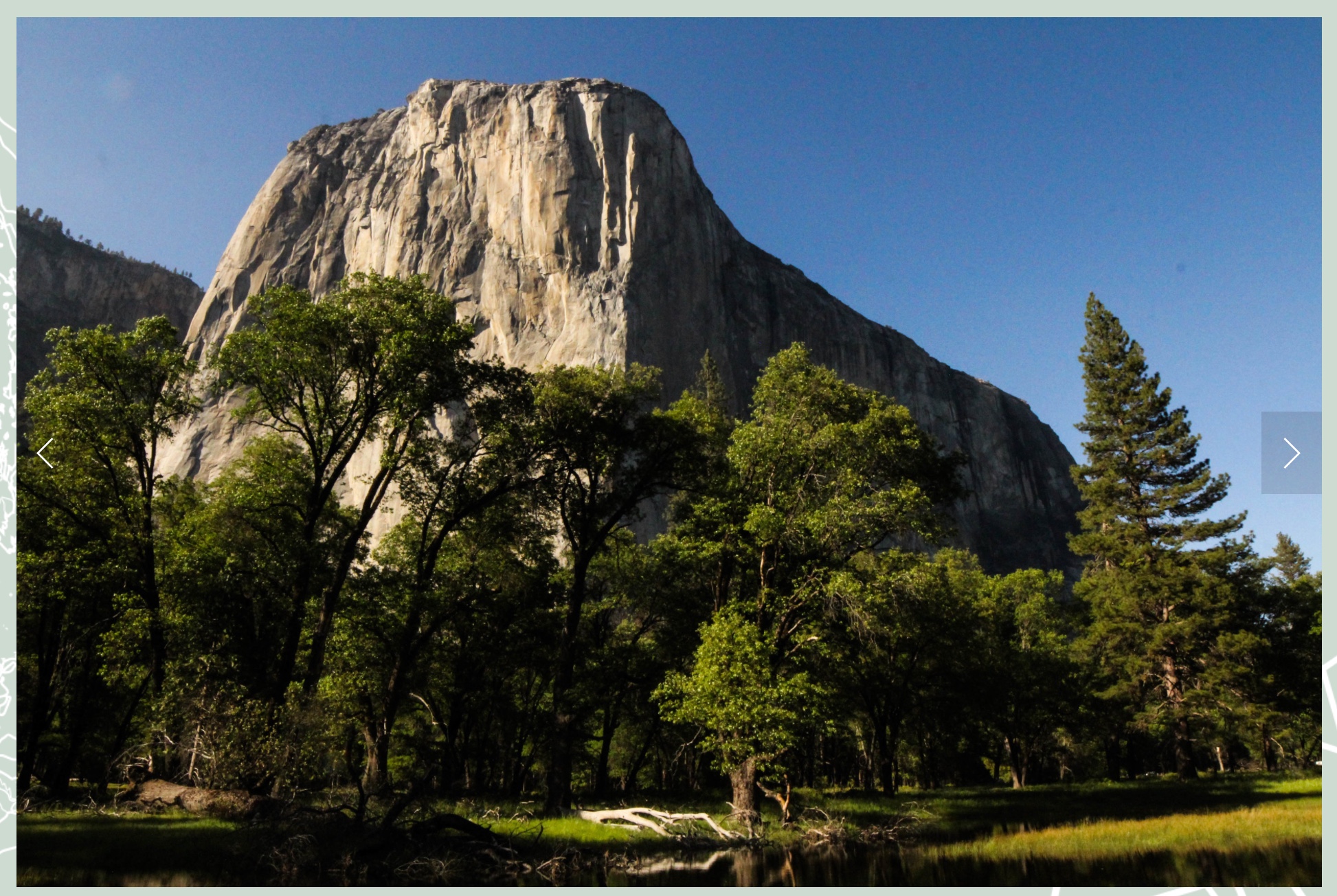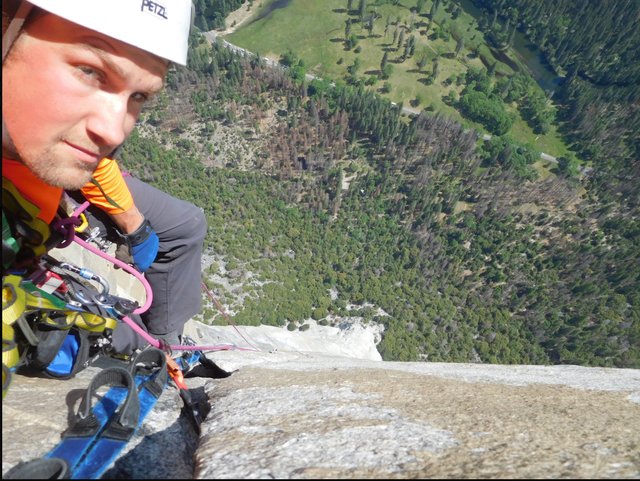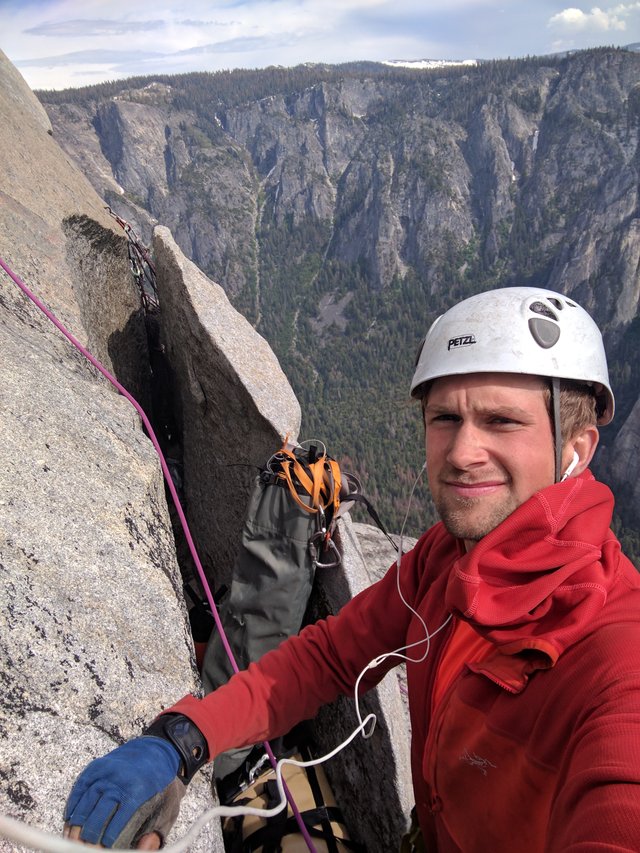Muir Wall Solo - solo BigWall Aid Climb
Muir Wall Solo

Day 1:
A friend helped me stash 8 days of food and water for a single person on heart ledges of El Capitan in Yosemite Valley National Park, after climbing Free Blast, a popular 8ish pitch* (depending on how you link pitches etc.) After a couple of days of rain, waiting back on the valley floor, I was ready to tackle the upper two thirds of the Muir Wall solo.
Day 2:
The second day went smoothly. I jugged* the fixed lines to Heart Ledges where my gear was stashed. I used my portaledge* fly to protect it during the couple days of rain leading up to the climb. My ropes got wet from the run off from the wall, but otherwise I was pleasantly surprised to find most of my gear dry and untampered with. As I was making my way to Heart Ledges, I ran into an old friend, Drew Smith, who I met in Cochamo Chile in 2012. We had a brief, but joyous reunion including a fist bump and some very quick catching up. Our routes split in different directions from Heart Ledges, and I was pleasantly amused by the playful banter between him and his partner while they worked their way up Freerider*.
Day 3:
From Heart Ledges the Muir Wall route goes one more pitch up and right to reach Mammoth Terrace, another good bivy* ledge for multiple people. Here I practiced, and figured out how to set up my portaledge by myself. This was a major concern of mine leading up to the climb because I wasn't sure if I could do it alone. I knew it was a thing people do because I've watched another soloist set one up on North America wall a couple of years ago. But when I had googled around the internet, I really hadn't found a good source on a method for how to do this. And as is typical to my procrastinating nature, I had not practiced at all while on the ground. So if anybody else finds themselves in this predicament, I made a quick youtube video, that you should be able to find now, and hopefully gives you something useful to go off of.
Day 3 consisted of climbing the pitches from Mammoth Terrace, up to the point where Muir Wall splits off from the Shield. I moved slowly this day because there were a few other parties also climbing these pitches, and I had to stop and wait to let them pass me. I wasn't bothered by this. It was fun to meet new people in such a spectacular place. The position of these pitches gives the climber an amazing vantage point to orient themselves to where the are on El Cap. To the Climber's left is the Salathe Wall, and at this point in the climb you can see most of the pitches from Heart Ledges up to El Cap spire along with all the climbers working on those pitches. Directly above is the Shield Headwall, which is an incredible feature to be staring at all day. Splitting off to the right and below this headwall is the traversing pitch for Muir Wall that moves into the corner system to the right of the Nose.
Day 4:
I had the traverse fixed from yesterday. This means that I climbed the pitch, attached my ropes to the next anchor, and came back down to the previous anchor. I did not want to sleep at my high point the night before because it was super windy as soon as I got out of the corner system below the Shield. So the morning of Day 4 I started out by cleaning this traverse pitch, and then dealing with getting the bags lowered out and hauling around the corner. This is always a fiasco for me, while climbing alone, because as a soloist, you sort of have to do everything right the first time if you don't want to jug up and down the pitch over an over again. Also, as soon as the haul bags are being lowered out into space, you can't easily change your mind and get them back. A minor difficulty occurred on this pitch when I did this... AsI lowered out the bag using a friends lower out rope they got all crazy tangled up in the lower out line. The bags and the rope were a be-jumbled mess in no-man's space and I could not think of a very good solution for how to fix the situation. I could not release the rope the way I had it set up, because it was running from me, back to the bags, tangled around the bags, and back to me. Out of frustration I got out a knife and cut the rope right in the middle where I was. (sorry Todd...) So now I had two, shorter ropes to use as lower outs for the rest of the trip. This actually proved to be quite useful.
The afternoon of Day 4 I started up the first C3 or A2 pitch. (see aid grades explained) The reason I chose to do the Muir Wall route was that I wanted more experience placing pitons. So this was the first pitch that I got to have that pleasant experience. Due to the educational nature of my goal, and feeling lonely and scared up high off the ground and away from the comforts of my lovely Vanellope, my resolve towards the admirable cause of Clean Aid Climbing was very thin, and I whipped out the hammer as soon as it became apparent that it would benefit my upward progress. The first nailing pitch went down pretty smoothly aside from it being very vegetated and requiring a fair bit of "gardening". It turned out to be a good confidence boost because it was probably the most difficult climbing I had done solo yet. Even though I have climbed significantly more difficult pitches with a partner, the mental aspects of being alone can be crippling.
After another chossy "easy" pitch, I finished up the day with a lovely squeeze chimney* ( heavy sarcasm, see definition ).
Day 5:
Breakfast for day 5 was served in the form of the ultra clean, and gorgeous C1 splitter*. This was the longest pitch on the route, just about 190 feet long. My daily self induced fiasco occurred about two thirds of the way up this pitch when the rope attached to my haul bags got hopelessly tangled and made upward progress exceedingly difficult. My best in the moment solution was to just clip it to my last piece of gear so that I could at least finish the pitch. Unfortunately this resulted in requiring me to go up and down the route an extra time for a total of 3 times, climbing that same 190 foot section. But hey, It gave me lots of time to enjoy the view of one of the most spectacular splitter cracks on the route! And jugging is just oh so much fun anyway.

After the C1 splitter fiasco, I got to another C3/A2 pitch. It was intimidating from below (as all of the pitches are) but once I got moving on it, It turned out to actually be one of my favorite pitches. It started with some climbing up into a high point, which I then lowered off of, and used to swing into a thin seam of a crack. Catching the thin seam was difficult, I grabbed a small pin scar in the rock with two fingers and then managed to finagle a small off-set cam* below me that just barely held my weight as I lightly nailed the first of many bird beaks* into the crack. The rest of the seam ate up small wires* and bird beaks like Pac-Man eats up pixilated white dots.
Day 6:
Day 6 was comprised of more C3/A2 pitches. The corner continued for a bit until eventually the route broke out onto an open face with probably my second favorite pitch. Another epic splitter crack wandered through the middle of a featureless face. I finished up these pitches and got the last good sized ledge before the summit. Ledges are always a special treat to get to. They make setting up the portaledge way easier, along with giving the climber a chance to really organize equipment, food, water, etc. Knowing that I had a good place to sleep gave me enough piece of mind to put a longer push in for the day, and I was able to fix the pitch above the ledge. I climbed until just around 8:30 PM, and got done right as the sun was going down. At this point in the climb I knew I would only have one more night on the wall, so I kicked back and stayed up late ish (probably only 10 PM) reading, and enjoying the view of the stars and car lights as they meandered around the road on the Valley floor.
Day 7:
Waking up on the last ledge, I enjoyed a casual breakfast and watched some super strong climbers work on freeing some of the upper sections of this wall. They rappelled in from the top, and were practicing the moves of a variation pitch that they had bolted and been working on for about the last two years. It is really fun to watch such proficient climbers in such an amazing location.
For me, the day of climbing would be more of the same aid climbing. I took my first and only fall this day when I neglected to check the route description and didn't bring the right gear with me. The crack called for some really big gear that I had left in the haulbags at the ledge, and when I tried to climb around the section using less then adequate equipment in a wet muddy crack, I quickly paid the price in the form of about a 15-20 foot fall. Dangling between my high point and the haulbags, I decided it might be prudent to go back down for the right equipment, since I was half way down anyway.
The next pitch could probably be considered the crux of the route. Rated C4/A2+. I had been curious to see what this grade would actually entail. It became obvious what this difficulty meant when I arrived at the base. Looking up at it, it looked as if everything that I would try and place would bottom out in the impossibly thin and shallow crack. But perhaps the greatest life lesson to be learned in Aid Climbing showed strongly in this moment. It is this; if you look at the entire pitch, it can seem overwhelmingly impossible, but if you look at just the single next move you have to do, with some thought and patience, a way to continue moving upwards will appear. If you can get in the habit of only concentrating on the single move in front of your face, executing it, and then continuing onward, without letting the moves several steps ahead of you get to your mental psyche, pretty soon you will find yourself making progress towards the top. Applying this, I managed to get through the crux pitch without incident. I did not climb it clean, so it got the A2+ rating for me. Hats off to whomever has climbed this clean, I had a very difficult time imagining how that was possible. I can only imagine that you would have to be top stepping* in your aid ladders off of very delicately hand placed beaks, back to back for the entire pitch.
I ended my day early here at around 5:30 PM to enjoy one last phenomenal night on El Capitan. The following day I only had 3 easy pitches to do, or so I thought...
Day 8:
This day was a day of traversing. The second to last pitch is about a 130' traverse to the left with mandatory free climbing and some balancing off tension from the rope. A fall during this pitch could mean a MEGA huge swing around the corner. I'm not sure the exact distance traveled, I'm sure some math savvy person could figure it out with some simple geometry, but imagine a pendulum with 80' of rope, and the poor climber that would be falling starting directly horizontal of the pivot point. It scared the last bit of pride out of me and I managed a desperate humbling grovel to the end. Oh wait... I forgot that I was soloing. Ya I had to reverse the traverse (boom sick rhyme) TWO more times, because I had to release the bags, and then climb back to the high point. Fortunately I knew what to expect, and already had the Beta dialed, so It wasn't quite as terrifying the next two times across.
The last pitch was a treat after the traverse. A short 60 ish feet of mostly easy free climbing lead me to the final top out. Trying to write about how it feels for me to get to the top of El Capitan is very difficult. I want to say some flowery thing about how overwhelmed with happiness at achieving this goal I was, and that I broke down in tears and stuff. But that would be a lie. For the most part, the top out is a little anti-climactic. I do feel a great sense of gratitude for having the opportunity to enjoy such a magnificent place for such a long period of time. But getting to the top is just another part of the journey. 8 days is a long time to spend by yourself, and it forces you into a mental space that is so different from where you are when leave the ground. When you have other people around, helping you, giving you opinions and advice, whether they are good or bad, you can still turn to somebody else for input. That option is unavailable on a solo climb. The only way for me to climb alone without becoming overwhelmed with the overall magnitude of what I am trying to accomplish, is to put myself into that different head space that I alluded to during the Day 7 account. The trick is to block out everything except the move immediately in front of you. In doing this, I am "living in the moment" more then I ever am during other parts of my life. I think that is why climbing is such a valuable way to learn life lessons. It forces you into a head space where nothing else matters, except the next move.
When I get to the top, I am still in that head space. I am appreciative of where I am, still loving everything so much, but nothing has changed just because I got to the top. Now I am still simply thinking, "what is the next move?", and the next move was pretty simple. I needed to get all this stuff that I just spent 8 days getting to the top, back to the bottom. And so, I spent the next day doing two trips shuttling my gear up and down the East Ledges descent. I complained a little about the second trip to some friends and myself, but once I got going, I really enjoyed the low key hiking to contrast the slow, tedious, and sometimes terrifying aid climbing that I had become accustomed to as a part of my daily life for the past week.
The Next Move:
For now, I am back in Bend Oregon. Enjoying some time with friends I haven't seen in a while. I am also practicing concentrating on what is immediately in front of me, trying not to worry too much about life plans and all that stuff that people get so caught up in. Not that it is a bad thing to plan, but for me, being present is such a wonderful feeling while climbing, I'd like to translate that to other aspects of my life, and be able to enjoy today as much as it deserves to be enjoyed. So now that I'm finally done writing all of this, I think I will head outside, down to the Depot by the lovely Deschutes River for some well deserved bouldering after all of that aid climbing. Peace
 ![selfie-elcap.jpeg]
![selfie-elcap.jpeg]
Great read and awesome photos! :) Sounds like an enjoyable journey :)
Thanks Steeks!
Very welcome! :) I will follow you for more great stories :)
Thanks man, I followed you and checked out your travel blog. Looks great!
Thank you and likewise! :)
Doing El Capitain is every climbers dream, but going for it solo with aid is just incredible!!!
Upvoted and resteemed by the @Climbing-Trail!
The @Climbing-Trail is an account dedicated to give climbing, alpinism and hiking a plattform here on Steemit. It is curated by @HaTo.
Thanks @Climbing-Trail , it's good to see more of the climbing community on steem. I will follow you!
Thanks! I can't wait for your next adventure!